A Japanese maple is one of the most easily recognizable trees thanks to its lovely red hue. These four-season trees fit well in practically any yard! Here’s everything you need to know about how to grow, plant, and even propagate a Japanese maple tree.
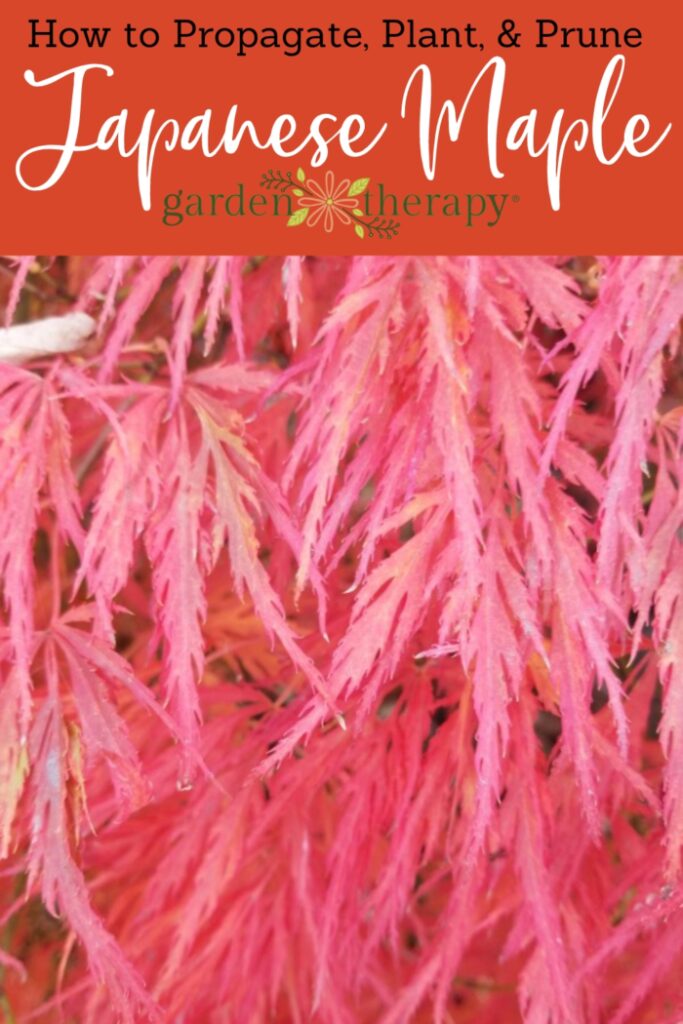
The Japanese maple is ideal as a tree that fits well in a small-space garden. And, yes, you can grow a Japanese maple tree in a container! There are many varieties of Japanese maples with brilliantly colored leaves, architectural branching structure, and interesting shapes.
With so many to choose from, you’re sure to be able to find one or two that would be a strong focal point in your garden.
How to Pick the Right Japanese Maple
When shopping for a Japanese maple, there are several things you will need to consider. Since there are thousands of varieties of this beautiful tree, here are a few tips to start narrowing it down.
Choose the Right Habit
Read the plant tag thoroughly to determine it’s habit, or what the final size and shape of the mature tree will be. There are three main types to choose from:
- If you want a smaller tree to be grown in a small garden or large container, choose a dwarf variety like ‘Red Dragon’ or ‘Little Princess’ that max out at 8 feet and 5 feet respectively. Read more about how to grow trees in containers here.
- A weeping variety like ‘Crimson Queen’ will do well if you would like a tree to perform as a shrub in your garden, taking up width and acting as a decorative garden feature.
- If you want a statement piece, look for a tall, colorful, upright Japanese maple that will range between 10 and 20 feet tall like ‘Bloodgood,’ ‘Purple Ghost,’ and ‘Coral Bark.’
Be sure to follow the planting instructions on the label that comes with your Japanese maple to ensure that it transitions well into your garden.
Choose the Correct Shape
Once you know the right variety of maple for your garden, it’s time to pick out the right shape of the individual tree. Pull the plant away from its brothers and sisters and look at it from all angles.
Make sure that the shape is attractive to you. A tree will naturally grow into that shape as it gets larger. It could have some pruning to help direct the shape, but the best practice is to choose a tree that you like the shape of when young rather than trying to fix it as it grows older.
Try to envision what the little tree will look like when it’s grown to full size with the same basic shape but thicket branches and trunk. If you like the shape, it’s the right tree for you.
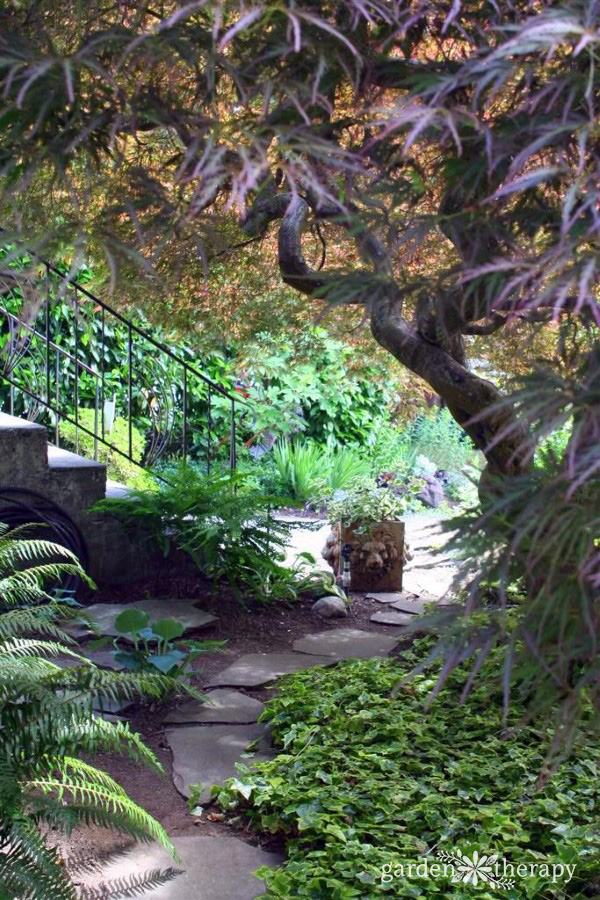
Growing Japanese Maple Trees
Japanese maples are beauties all year long with their attractive branch structure in the winter, little helicopter seeds and flowers in the spring, gorgeous full maple leaves in the summer, and brilliant neon-bright color in the fall.
When it comes to small trees, Japanese maples really are the king. Here’s what you need to know about growing Japanese maples that thrive.
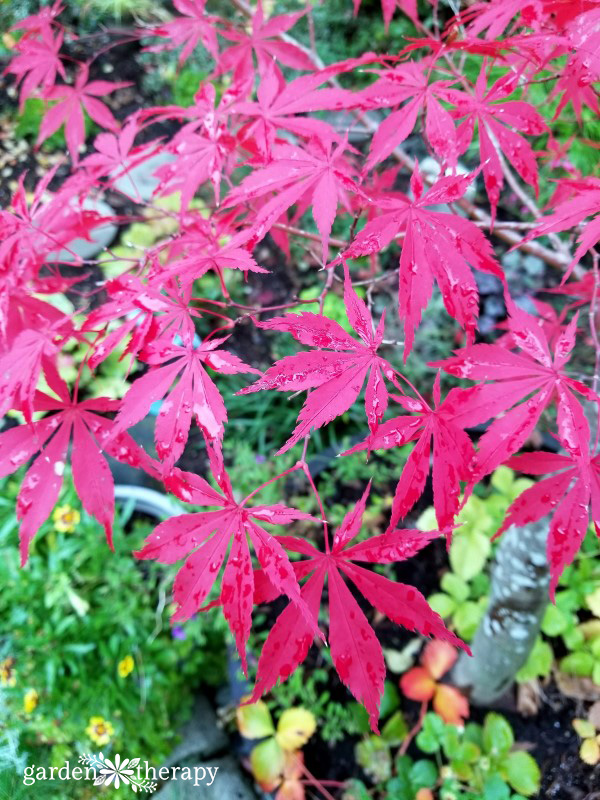
What Zones do Japanese Maple Trees Grow in?
A Japanese maple may be a fair-weather friend, but for those who have the right conditions, you’ll get months of beauty from one small tree.
Japanese maples do well in zones 5 through 8 and like a temperate climate without deep winter freeze or blistering summer sun. They grow perfectly in my Vancouver, BC garden.
In fact, within my small urban garden, I have four Japanese maples. It’s probably one (or three) too many for such a small space, but I’m at peace with my penchant for plant hoarding. Let’s not invite any of the other members of my family to weigh in on it though!
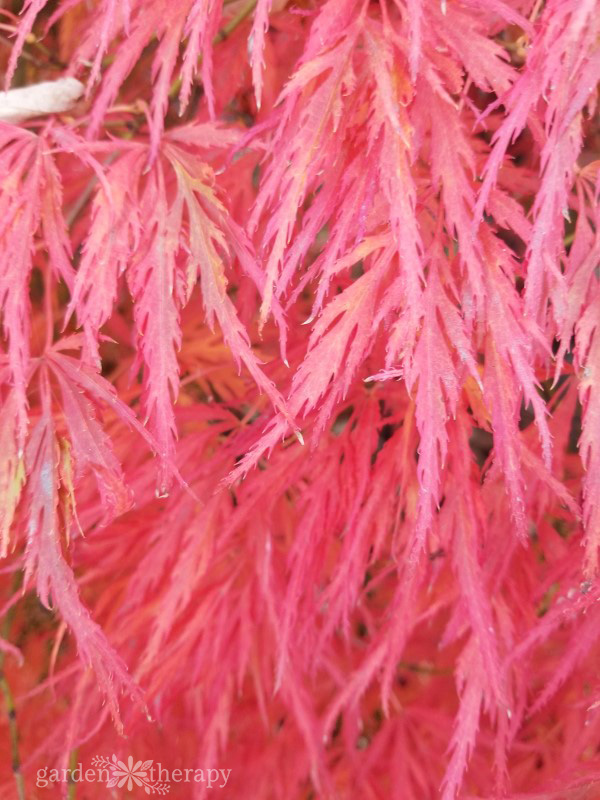
Do Japanese Maples Prefer Sun or Shade?
These trees do well in either a sunny location or one with dappled shade. They do need some sun to thrive and give off that pretty red fall hue, so they are best kept in a location with at least some sunshine.
Just keep in mind that a Japanese maple in a container in the hot sun can dry out quickly. Without enough water in the soil to keep it hydrated, the leaves can quickly turn crispy.
How to Prune a Japanese Maple Tree
When you pick out the right tree, it won’t need a lot of pruning. It will grow and fill in the space that you’ve provided for it without needing to be cut down for size. It should also have a gorgeous branching structure that’s natural and organic.
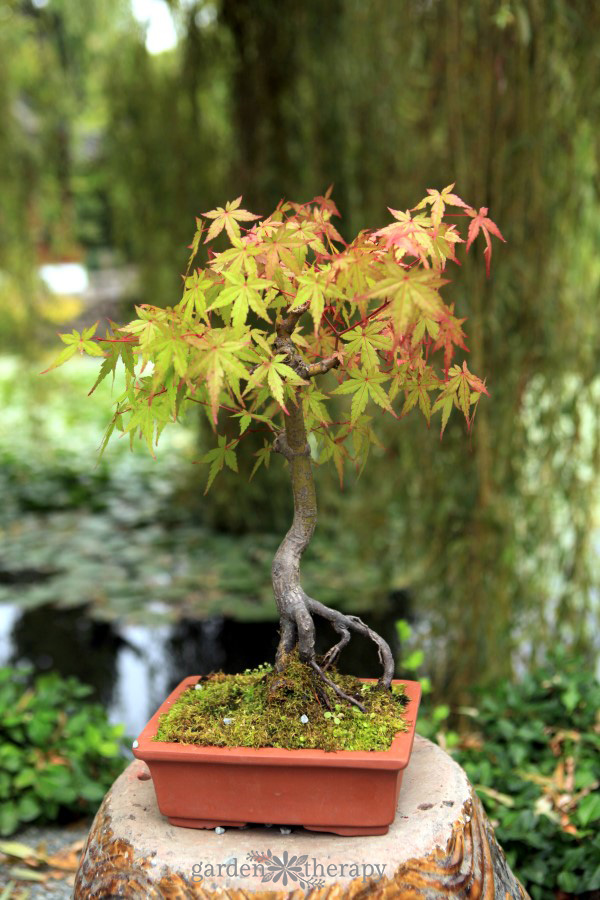
If you find that the Japanese maple is getting too dense then it’s best to go into the maple and thin out branches rather than head cutting the branches. The more you go in and remove branches as close to the trunk as possible and keep the organic structure, the more you will be able to see and enjoy the true beauty of a Japanese maple as it grows in your garden.
Propagating Japanese Maples
Have you ever been curious about how to propagate a Japanese maple tree? It’s actually a fascinating process that I got to see in detail during a trip to the Monrovia Nursery in Dayton, Oregon.

The Japanese maples Monrovia grows are all grafted on the same rootstock. This means that no matter what the branches and leaves look like in the end, they all started off with the same seed, Acer palmatum. The rootstock is grown from seed and once they are large enough, different varieties of maple branches will be grafted onto them.
How to Graft a Japanese Maple
When the saplings are old enough, they are fused with a branch cutting from a different decorative Japanese maple.
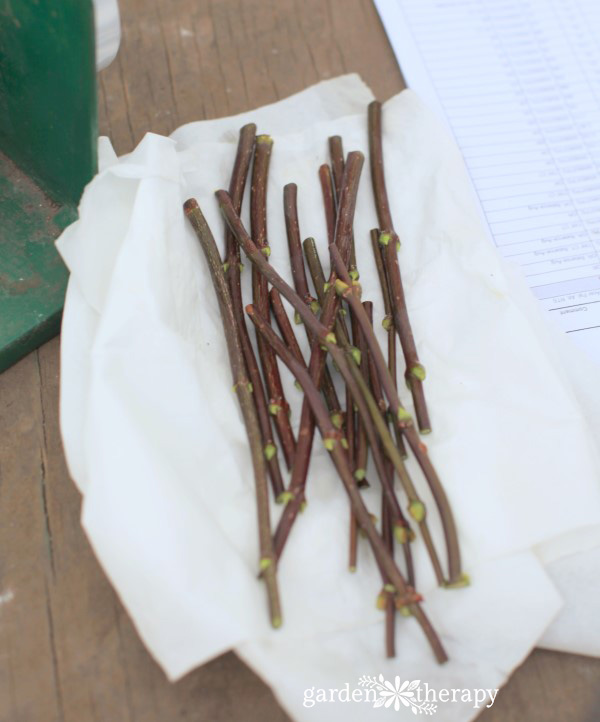
Grafting is both an art and a science. It is done by slicing a notch in a tree branch and inserting another branch into the notch. The two are bound together until they fuse together and grow as one. If you have a Japanese maple at home, look to see where this grafting took place on the base of the trunk. There should be a “collar,” or ring, around the grafted branch.
It can be handy to know where a tree has been grafted because if a branch grows from below the collar it will have the characteristics of the original rootstock. I occasionally notice a rogue branch with leaves that are different from the rest of the tree on one of my Japanese maples. This is a result of the grafting process. The branch has some of the characteristics of the rootstock.
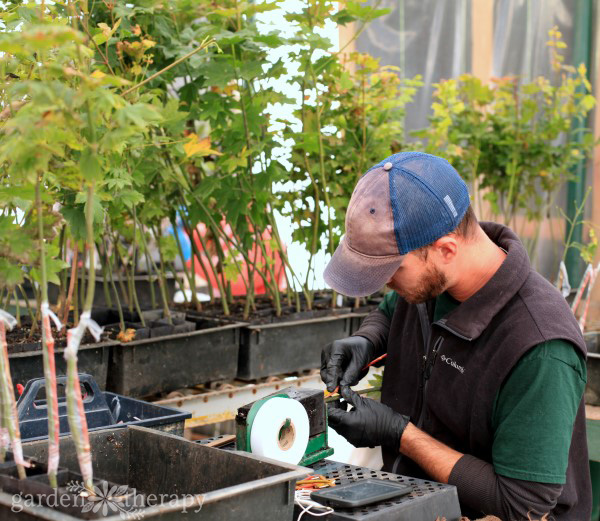
Next, the little sapling with the graft is potted and grown for another few years. Japanese maples take very well to pruning and they are shaped regularly to keep them uniform as they grow large enough to be shipped to the garden centers.
How to Propagate a Japanese Maple Tree at Home
Now that you know how commercial growers propagate this tree, you may be wondering if you can do the same at home. The answer is yes! The process is a bit time-consuming but simple enough for most gardeners to do. It’s best to do this in the springtime as the branches are soft and more pliable.
- Fill a container with potting soil, and create a hole about 4″ deep in the centre.
- Take a cutting from your tree. Look for one that is about 6″ long and has leaves at the end. Make sure to use sharp shears for a clean cut!
- If there are any leaves on the branch beside the ones on the end, remove them.
- Soak the cutting in liquid rooting hormone for about 1 minute.
- Insert the cutting into the soil you prepared, and set it in a sunny location.
- Mist it twice daily. The branch should start to sprout roots in about 3-4 weeks.
You’ll want to keep your propagated Japanese maple in a pot for about a year. Once spring rolls around again and temperatures are above freezing, you can plant the tree directly into the ground.
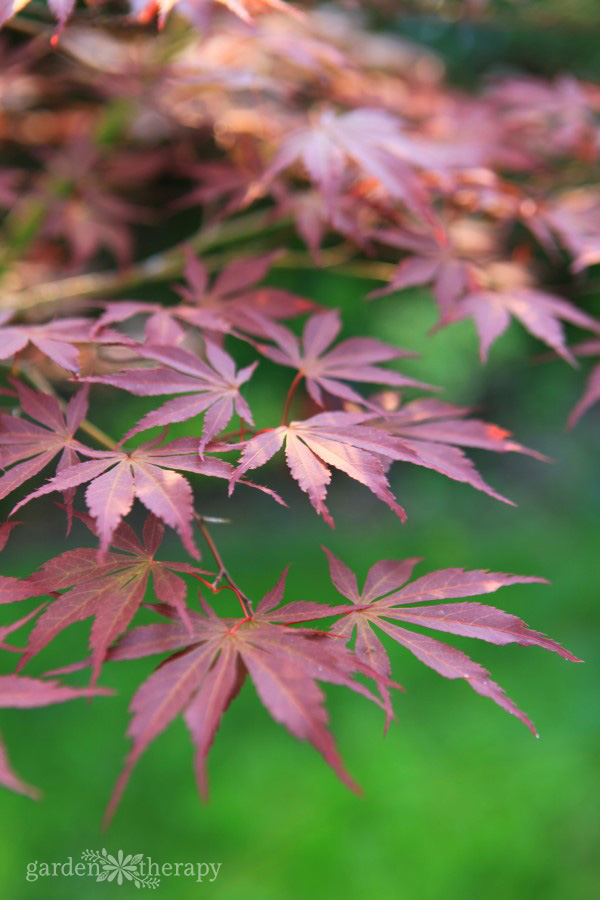
Once you have your Japanese maple tree planted in your space, you’ll be able to enjoy its beautiful foliage year after year. If you choose the right tree and care for it, you’ll be rewarded with decades of beauty.




I cut my maple tree (palmatum black lace) in Sept (London, UK) right down to the trunk and I keep the long young branches in the garden (without leaves) in a corner (some are 2 or 3 meters long) The next spring, I cut those long branches into 60 cm long and put them straight into soil….. All the ones that had nacient leaves but never came out the previous year, become a little tree. They are a pleasure.
Maz can you clarify “keep young branches in a corner”? Once tou cut these branches from the main plant, do you just set them aside or you put them in a pitted soul immediately?
This will be my first time attempting propagating a maple tree and want to make sure I’m doing it right.
Love Japanese maples and bonsai. Wish I had more time. Loved the info Steve Crawford
I got a Japanese maple, and it has a grafted branch at the bottom! Do I remove and propagate it?
Hi Kristen, the branch at the bottom is likely growing from the root stock not the graft. The graft would have been the the branches and leaves above that you expect. Just sni that branch off, yes, and if you want to root it for a different tree, go for it!
I have a cutting from a Japanese maple a lady gave me ,I have it in a pot on my deck but It doesn’t seem to be growing ,is there something I should be doing ?